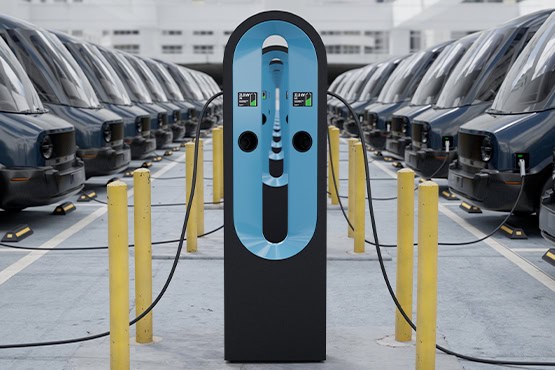Transportation is at the center of North America’s climate challenge—and its opportunity. It’s the largest source of greenhouse gas emissions in the United States (accounting for over 39% of energy-related CO2 emissions, according to the EIA), and the second-largest in Canada. These emissions not only fuel climate change, they also contribute to serious health impacts, especially for communities located near major freight corridors, highways, and ports.

But that story is changing fast. Electric vehicles (EVs) and charging infrastructure are emerging as the most scalable alternative fuel solution available today. And with them comes a broader shift: a transportation system increasingly powered by clean electricity, connected technologies, and flexible infrastructure.
At EVCAN, we focus on what makes this shift work—not just the vehicles, but the complex ecosystem of charging infrastructure, cloud solutions, and grid integration strategies behind them. We provide an impartial perspective encouraging industry and market stakeholders to adopt practices and policies that aid in scaling the deployment of charging infrastructure. Making the transition work will take coordination, robust standards, and tools that help everyone—from utilities and city planners to technology vendors and public agencies—move forward with clarity.
Electric transportation refers to the growing network of vehicles, charging stations, and software platforms designed to move people and goods using electricity instead of fossil fuels.
Electric transportation isn’t just a technology shift. Because transportation touches nearly every aspect of daily life, from economic security to personal mobility, this transition requires both technology adoption and behavior change. This change impacts how we drive, when and where we refuel, and how transportation integrates with energy systems and city planning. Electric transportation involves a diverse landscape of technical needs and capabilities:
From sedans and SUVs to delivery vans, school buses, and long-haul trucks.
Installed at homes, workplaces, highways, and public sites—and scaled to meet growing demand.
Such as vehicle-to-grid (V2G), vehicle-to-home (V2H), and vehicle-to-building (V2B), where EVs can send energy back into the system.
Coordinate when and how vehicles charge to support grid stability, pricing signals, reliability, roaming, and driver experience.
Ensures adequate power is delivered safely and reliably to the charging infrastructure at any time of the day.
Streamlines ongoing maintenance and benefits tracking and transparency.
Just a few years ago, EVs were seen as niche. Today, they’re reshaping the auto industry and energy policy across North America:
In Q4 2024, EVs made up 8.7% of new vehicle sales in the U.S., with over 365,000 sold in that quarter alone.
Over 100 models of electric vehicles are available for purchase today.
In Canada, federal and provincial efforts are building infrastructure to support a national goal of 100% zero-emission vehicle sales by 2035.
The shift is backed by billions in public investment and growing private sector momentum. But the infrastructure needed to keep pace with this growth is massive—and must deliver not just coverage, but reliability, interoperability, and a positive charging experience for every user. As adoption grows year over year, regulators, utilities, and communities are considering how to invest in infrastructure, workforce, and policies that support long-term scalability and equity.
Despite progress, several challenges still limit the scalability of electric transportation. These aren’t just technical issues—they shape public trust, business viability, and infrastructure equity. A more reliable, connected, and intuitive charging experience will be key to unlocking mass adoption.
Electric transportation doesn’t belong to a single sector. It’s a shared project, and each stakeholder plays a different role in making progress possible:
Utility Program Managers are navigating how to integrate EV demand into existing systems, evaluate new technologies, and ensure reliability and satisfaction for customers. Many are under pressure to scale quickly while managing unprecedented load growth and transforming an aging grid system.
Charge Management and Network Service Providers are trying to demonstrate value, grow their business, gain trust with utilities, and comply with fragmented requirements across states and provinces. Education, testing, and transparency all take time.
DERMS Providers are working to aggregate EV charging load and demonstrate EVs as a valuable resource for grid services. But integration is complex, and customer engagement models are continuing to evolve.
Municipal and State Agencies are designing incentive programs and procurement strategies, often under pressure to move quickly while also balancing constituent expectations and navigating an EV charging landscape without fully standardized solutions.
OEMs and Contractors are deploying hardware, managing installations, and seeking to leverage the available utility and government funding to offset the upfront costs for their customers.
Community Organizations and Policy Advocates are working to educate and engage underserved communities and advocating for equitable infrastructure access in urban and rural areas alike.
Each of these groups has distinct needs—but they also share overlapping goals. That’s why collaboration matters. When stakeholders coordinate early and often, they can reduce risk, speed deployment, and shape smarter, more consistent infrastructure together.

EVCAN exists to support this collaboration. As a neutral convener, we:
Ready to take the next step? Here’s how to get involved:
Subscribe for updates on technical resources, events, and webinars.
Want to get involved, learn from peers, or share your perspective? Contact our team